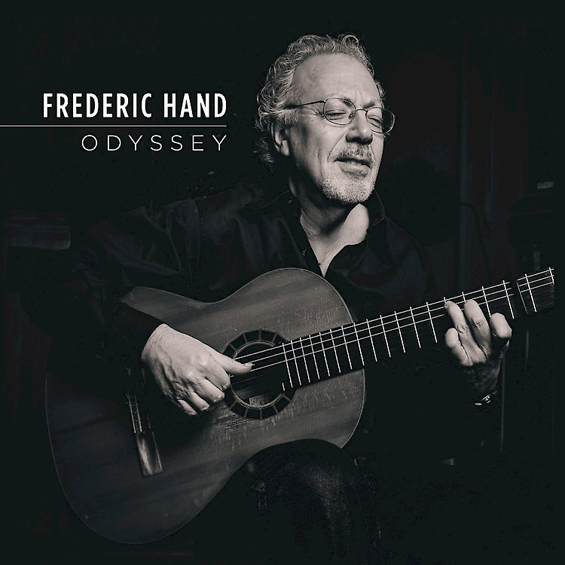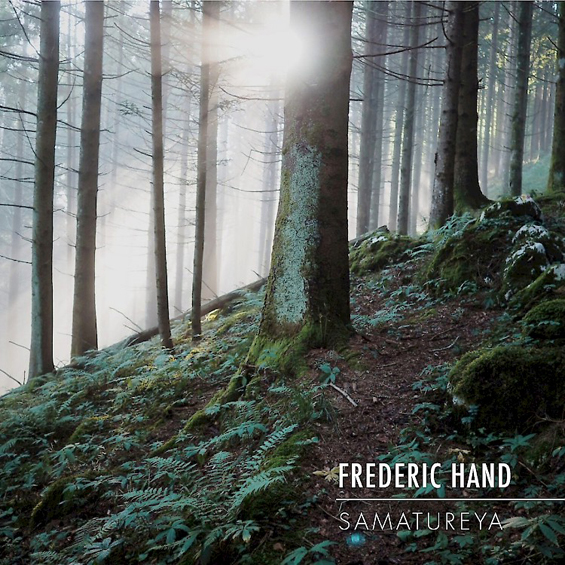

TEN QUESTIONS WITH FREDERIC HAND
It's no exaggeration to say Frederic Hand has enjoyed a career unlike any other classical guitarist's. Consider: his playing has been heard on the scores of numerous films and television series, among them Kramer vs Kramer, Sesame Street, and The Guiding Light; he's performed onstage with Placido Domingo and Luciano Pavarotti; has played guitar with the Metropolitan Opera since 1984; and has even performed on Broadway with Maximillian Schell in a production of John Osborne's A Patriot for Me. This Grammy-nominated and Emmy-winning recording artist also has issued a number of fine recordings, most recently Samatureya, a stellar collection of Hand-composed solo and chamber pieces. textura was honoured to interview recently this renowned musician and discuss the new release, his experiences playing with the Metropolitan Opera, and other matters.
1. Many years ago, you studied in England with Julian Bream after being awarded a Fulbright Scholarship. What long-term impact did studying with this legendary guitarist have?
In a way, I began studying with Julian Bream through his recordings and concerts, long before working with him in Canada and England. From the moment I heard his recordings, I was focused on his sound, expressivity, and rhythmic vitality. His repertoire introduced me to renaissance dances and fantasias and baroque suites, and many contemporary works. His long-term impact has been on my sense of tone production, use of a wide variety of timbres, and a deeper, more intuitive perspective of phrasing.
2. Unless circumstances have changed since your 2016 textura spotlight appearance, you live in Woodstock, NY and travel to the city a few days a week to teach at Mannes College and perform with the Metropolitan Opera. As you've held the position of guitarist and lutenist with the opera company for thirty-four years, I'm guessing you've had a memorable experience or two in that role. Could you share a couple with us?
My most memorable moment at the Met came in a performance of Francesca Di Rimini by Zandonai. My lute was knocked off a chair backstage and badly damaged, just seconds before I had to play on stage in a scene with Placido Domingo. The chanterelle (tuning peg for the top string) was broken off along with the string itself. I had to re-voice all of the chords on the spot. It was a surreal experience, and as it was happening, I was both terrified and exhilarated.
3. Are there any operatic works that are particular favourites and that you're fond of performing?
My favourite operas to perform are Il Barbieri di Siviglia (The Barber of Seville) by Rossini and Wozzeck by Berg. In the Rossini, I add my own ornaments and arpeggios and both of the tenor arias with guitar are so beautiful and an important part of the opera. In Wozzeck, I'm in the stage band. We're playing completely different music than the orchestra, and there's a great deal of action on stage. The coordination of these various elements is enormously challenging. I particularly enjoy the score, which is incredible on so many levels.

4. When I heard that your follow-up to Odyssey was coming out, I wondered if Samatureya could possibly match the excellence of its predecessor and of course was thrilled to discover that it does. What for you are the key differences between the two projects?
Both Odyssey and Samatureya are deeply personal recordings because with the exception of one piece the music is all original compositions. Samatureya has more assisting musicians and chamber music, including a seventeen-minute flute-and-guitar piece, a trio for viola, flute and guitar, and a Chorale for guitar quartet, in which I played all four parts (with the help of my brilliant engineer and co-producer, Dave Cook).
5. Did you feel any pressure to live up to the high standard set by Odyssey when you turned your attention to its follow-up?
I always feel pressure when recording because the session will only capture a snap-shot in time of how I played the pieces that particular day. But that snap-shot is preserved, and I'm going to have to live with it for the rest of my life. So it's important that I feel I've done my best and that the recordings represent the music in the best possible light. That said, it's also important not to drive yourself crazy with the standard of perfection.
Someone very wise once advised me to use the concept of perfection as a beacon and not a bludgeon. It's often hard to maintain a healthy perspective at the end of a long recording day. I allow some time between the recording sessions and editing, mixing, and sequencing. My initial impressions usually change as I live with the recording.

6. Samatureya features a number of solo guitar pieces performed by you but also includes contributions from guests: guitarists João Luiz and Douglas Lora (Brasil Guitar Duo); flutist Amy Porter, violist Juan-Miguel Hernandez, and João Luiz (Trio Virado); and legendary flutist Paula Robison. What was the experience like of working with these guests, one of who, Luiz, was once your student?
It was wonderful! The nature of the classical guitar is that of a soloistic instrument. But I'm most happiest when making music with other musicians. In this case, they are some of the premier instrumentalists performing today. Paula Robison is one of the great flutists of our time, being introduced to the pubic by Leonard Bernstein's Young Poeple's Concerts. Performing with Paula has been a tremendous learning experience for me as she embodies incredible spirit, heart and authenticity. Joao and Douglas (Brasil Guitar Duo) are extraordinarily gifted and enjoying a well-deserved, wonderful career. Joao, (who lives in New York) and I have become good friends and have done lots of work together. He also formed a trio with two great virtuosos, Amy Porter and Juan-Miguel Hernandez. Their recordings of “Light Through the Trees” and “Samatureya” are so beautiful I saw no reason to re-record it. It is exactly as I had envisioned it.
7. Separate pieces on the album were composed for Dr. Martin Luther King Jr. and Leonard Bernstein. In what specific ways did these seminal American figures have an impact on your life?
As a teenager I attended the famous 'March On Washington' and saw Dr. King give his “I have a Dream” speech to an enormous gathering of people of all ages and walks of life. Five years later, when I heard the heartbreaking news of his death, I wrote an “Elegy” for him that same night.
Leonard Bernstein remains one of my greatest compositional influences, along with Aaron Copland and Samuel Barber. Bernstein's musical language often finds its way into my work and that influence continues to this day.
8. I found it interesting that in that 2016 spotlight you cited James Taylor as one of your favourite guitarists (Bream, Andrés Segovia, and Jim Hall are some of the others mentioned). Such a choice suggested to me that for you it's not only a matter of technical facility (not to suggest Taylor doesn't have his share) but touch, feel, and note selection. Is there anything in your own playing that you continue to work on and refine, even after having played for as many years as you have?
I continue to seek the most comfortable way to hold the guitar, affording both hands and my entire body maximum relaxation. This has been a lifelong endeavour. Initially, I was trained to hold the guitar on the left leg, which was elevated by a footstool. But when I studied jazz, everybody was holding the guitar every which way. I found that I played better with the guitar on the right leg. I caught hell from classical guitar aficionados for doing that, but I really didn't care. However, elevating either leg is not good for the lower back. So I continue to experiment with various devices that attach to the guitar and elevate it, allowing both feet to remain on the floor.

9. Listening to Samatureya sans background info, you'd never guess it includes both recently recorded material (Chorale, Trio, Still, The Maverick) and pieces recorded in 2000-2001 (Heart's Song, Samba, For Lenny, Elegy for Dr. Martin Luther King Jr., About Time, Lesley's Song); further to that, the Trio Virado performance of Trio actually originally appeared on the group's debut recording Mangabeira (Soundset Recordings). As the project progressed and as you were sequencing it, did you become especially focused on ensuring that it would sound like a cohesive set?
I absolutely did, and I'm so happy to hear you say that it sounds cohesive. That was one of the great challenges of this recording, precisely because of all the reasons you stated. After an album is recorded, I try out several different sequencing orders, listening for smooth transitions in the flow of the music from one piece to the next. That includes not only the music's emotional qualities, but also the sound quality and timbral differences between tracks. Sometimes just adding an extra second or two between pieces can make all the difference for a satisfying transition. Also, an individual track can sound very pleasing on its own, but in the context of the surrounding music, might need to have the e.q. or reverb modified, or a different mix of microphones, to make it blend better with the rest of the album.
10. Finally, where did the album title come from?
Joao Luiz called me after Trio Virado recorded my trio and asked if I had titles for the two movements. I thought about the essential quality of the first movement and the image of a dappled light through trees came to me, but for the second movement, I could not think of a title. Then I remembered that this movement uses the first movement's theme and explores it much deeper, expanding it greatly. Suddenly the word ‘Samatureya' popped into my head. From where it came I do not know. It doesn't exist in any language. The meaning I ascribe to it is: “That which lies beyond the light through the trees.”
June 2018![]()